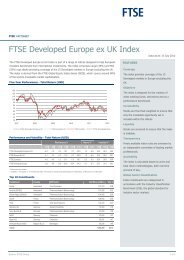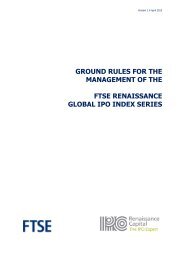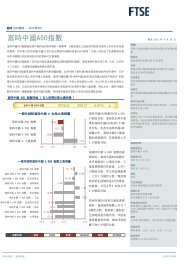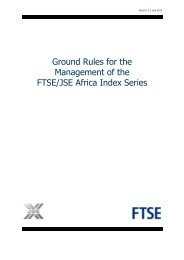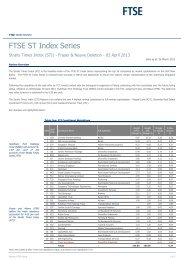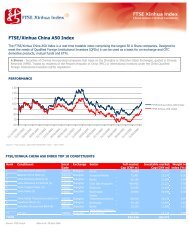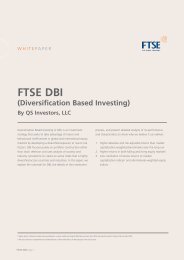You also want an ePaper? Increase the reach of your titles
YUMPU automatically turns print PDFs into web optimized ePapers that Google loves.
thoughts and expectations of relative value. Expect a<br />
debate in due course.<br />
DR. LOUIS HAGEN: The current crisis has clearly<br />
demonstrated that covered bonds have been able to<br />
withstand the earth quake when other funding markets<br />
especially structured products had already been destroyed.<br />
Within the covered bond family again we saw a substantial<br />
spread differentiation with some products showing more<br />
resilience than others. Since September we are in a<br />
situation in which it seems that almost only government<br />
products or government guaranteed products are able to<br />
attract a wider audience. But even within the government<br />
sector there is a wide range of differentiation.<br />
CARLOS STILIANOPOULOS: The strengths of the<br />
Covered Bond product has been highlighted by current<br />
market conditions. Even though spreads have widened<br />
substantially, demand has remained relatively strong<br />
during this period. There have been many private<br />
placements done in the Covered Bond market lately, and<br />
this shows there is still investor appetite for the product<br />
which cannot be said for other asset classes. The reason<br />
for this? Probably because of the strength of the product<br />
in itself.<br />
Given the depth of the current crisis, how might it<br />
impact on the covered bond market in the<br />
immediate term?<br />
TIM SKEET: The once homogeneous asset class has<br />
definitively splintered by geography, structure and issuer<br />
into a hitherto unanticipated pattern. Each jurisdiction<br />
makes claims about the robust nature of its domestic<br />
bonds, although investors do not always appear to be<br />
swayed by the arguments. Divergent nominal trading levels<br />
in the secondary markets illustrate this. Gone probably<br />
forever is the notion that this is a unified asset class. This<br />
realisation represents furthermore a challenge which will<br />
require more work on the part of investors. Let us hope<br />
that the market, with its cadre of analysts supported in<br />
future by credit and macroeconomic specialists, will rise to<br />
this. Better communication, greater transparency and<br />
attention to the mechanics of transactions will be required.<br />
The way that this will impact spreads and where the asset<br />
class trades relative to senior unsecured or agency debt is<br />
not clear. Nevertheless, the degree of government support,<br />
specific laws in many cases, and security on the back of<br />
prime bank credits should combine to preserve the<br />
premium quality status of most of the asset class. Market<br />
practitioners can still dream on.<br />
What does the issuance calendar look like for the rest<br />
of this year and for the first half of 2009?<br />
DR. LOUIS HAGEN: We do expect issuance to gain<br />
momentum in 2009 especially in maturities beyond the 3-<br />
F T S E G L O B A L M A R K E T S • J A N U A R Y / F E B R U A R Y 2 0 0 9<br />
year tenor, although very gradually given the increased<br />
competition from agencies and guaranteed bank bonds.<br />
TED LORD: Many covered bond issuers are looking for the<br />
opportunity to come to the market should conditions<br />
improve. The stronger names with solid business models<br />
should lead the way in the tough markets for 2009.<br />
Investors want to purchase names that can keep doing a<br />
profitable business in the current climate and those firms<br />
that are not too highly leveraged.<br />
Why did registered covered bonds become more<br />
popular over the summer of 2008? Was it to avoid any<br />
mark to market adjustments? Or is that too simplistic<br />
and where other issues in play?<br />
DR. LOUIS HAGEN: Registered bonds are an important<br />
pillar of the Pfandbrief market. About one third of 840<br />
billion Euro Pfandbrief outstanding comes in registered<br />
format. Registered Pfandbrief offer more flexibility to many<br />
institutional investors like insurance companies and other<br />
banks given they do not have to mark them to market. In<br />
times of severe dislocations like today institutional<br />
investors resort to registered bonds given the lack of any<br />
indication of fair values. In addition most registered<br />
Pfandbrief are tailor made at the request of the investor.<br />
Was the jumbo covered bond market more or less<br />
impacted by the crisis than other covered bonds?<br />
TIM SKEET: Trading had been one of the market’s key<br />
attractions. Jumbos offered a real sense of liquidity relative<br />
to other asset classes. The jumbo market-making<br />
conventions in force proved excellent for fair weather<br />
trading, but exacerbated the spiral when the winds turned.<br />
Now the market is wrecked, how best should the traders<br />
set about moving forward? Optimists point to the fact that<br />
members of the trading community are taking the initiative<br />
and moving towards more open and modern trading<br />
standards that suit variable market conditions better. It is<br />
likely that although Jumbo trading and that sector of the<br />
market will revive in due course, more flexible issue sizes<br />
may emerge into the mainstream, offering issuers greater<br />
control over maturities, and investors more choice on<br />
spread and other parameters. Rating agencies may<br />
encourage this in order to alleviate refinancing risks. It is<br />
therefore possible that issues of say €500m will be more<br />
frequently seen in future and more flexible taps (as seen<br />
recently in the Pfandbrief sector).<br />
DR. LOUIS HAGEN: One cannot compare the Jumbo<br />
market with the traditional market. The Jumbo model aims<br />
at providing liquidity to the investor whereas traditional<br />
Pfandbrief does not. The liquidity of the Jumbo Pfandbrief<br />
was impacted first having proven its resilience quite a long<br />
time after the crisis loomed in summer 2007 when spreads<br />
had remained almost unaffected as had volumes.<br />
77



